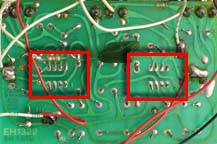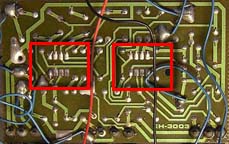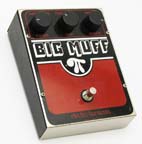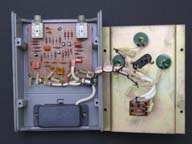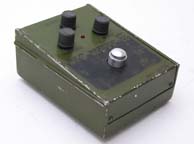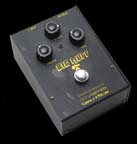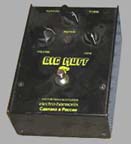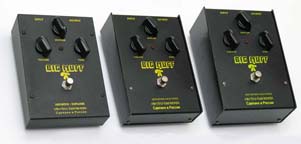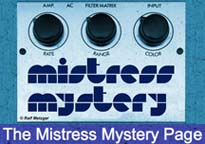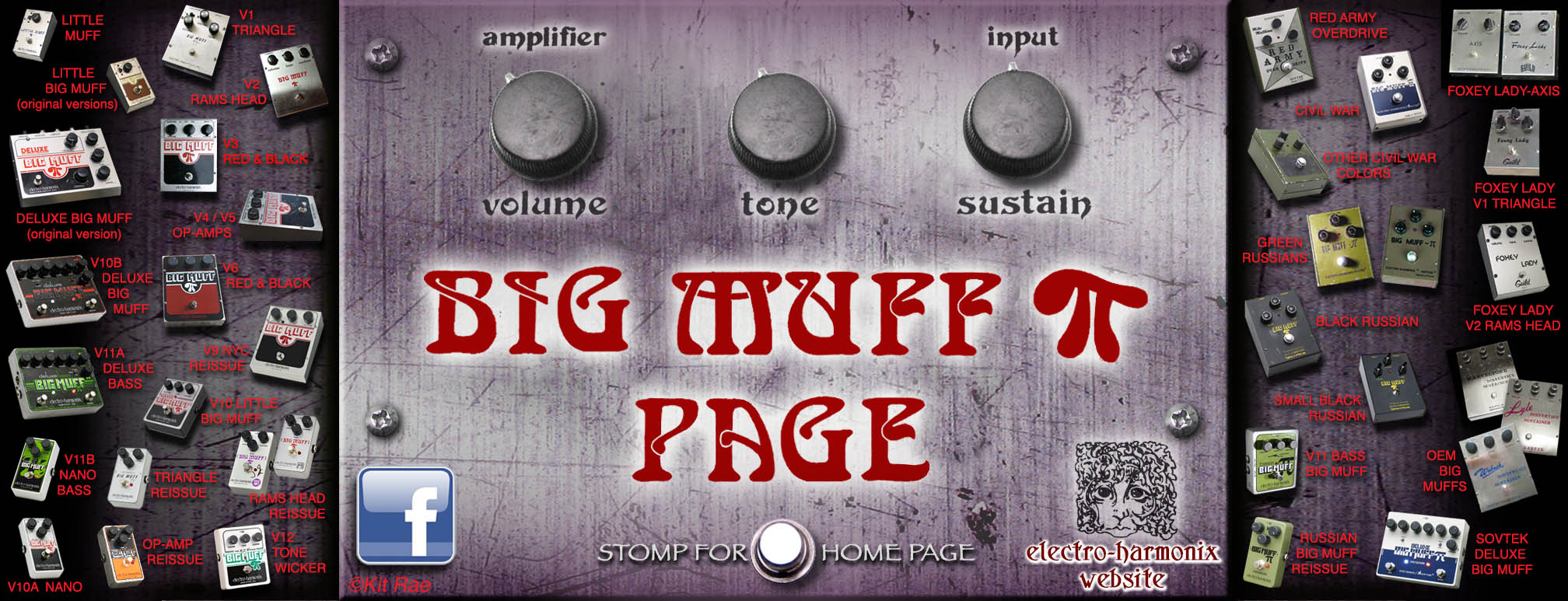
THE SIMPLE SUMMARY - TONAL DIFFERENCES IN ALL BIG MUFF VERSIONS, VINTAGE TO MODERN
AND QUICK IDENTIFIER
For a more comprehensive version guide, click on any of the icons above.
Version 1 - "TRIANGLE" BIG MUFF (USA circa 1969) - What a V1 "Triangle" Big Muff sounds like is a bit complicated. The tone of the V1 Triangle Big Muff has been described as the best sounding of all the Big Muffs, but in fact, here is no single Triangle Big Muff sound. There are several. The reason many people say the "Triangle is the best" is probably due to a few early circuit traces of a couple of uncommon circuit variants that circulated for several years. Most clones were based on those, so that is what people who never played an original thought a Triangle was supposed to sound like. Considering that there were at least 18 different circuit variants used, there is probably more sound variance in the V1 than any other version due to this. The V1 and V2 (Ram's Head) Big Muffs both spanned a similar range of circuit variants, so in that regard, some V1s sound the same as some V2s, and many do not. In general, I find that most of the V1 circuit varants in my collection cut through a band mix very well, are very articulate for leads, and have a nice, warm crunch for power chords and palm muting.
The very early, and VERY rare perf board V1 circuits had a really unique sound in the low end and lower mid range that most of the later V1 and V2 circuits variants did not have. They were not especially high gain, but had smooth, long sustain, and fat, warm bass frequencies. Then there are some attributes that define a "typical" V1, and I use that term loosely. The most common circuit variant used did not sound all that different from some of the more common circuit variants in the V2 enclosure. The mid range was very "scooped", or removed. Sustain was exceptional, and gain was moderate, as was the low end. Then there are the other, less common V1 circuit variants that had much more low end, giving them a monstrous sound when playing power chords, but some found the low end too flabby and muddy. The bass and treble frequencies vary quite a bit from one circuit variant to another, as does the gain, fuzziness, and clarity on notes. In the extreme ranges you may find some are very bright, thin, and gainy/fuzzy sounding, some smooth and fat, some more thick and chunky, et cetera.This wide variety in sounds is one reason V1 Big Muffs are so collectible. You can have two different V1 circuit variants that sound roughly the same through an amp. Then you blend both with an overdrive and you find one sounds very different than the other. Or blend both with a modulation effect like an Electric Mistress and one may filter the modulation frequencies differently than the other. You may even find that two different V1 circuits sound the same through one amp, but different through another amp.
Then there are the tone circuit differences. Two V1s, each with a different circuit variant inside, may sound nearly identical when both tone knobs set the at 12:00, for example. Dial both into the bass range and one may sound muddy and useless, where the other sounds warm and articulate. Or dial both to the treble side and one sounds harsh and trebly, but bright and compressed in the other. V1 and V2 Big Muffs are like that.
V1 QUICK IDENTIFIER - Both editions have a triangular knob layout. First Edition: No separate power switch, hand wired on perforated circuit board. Some have a printed circuit board. Second Edition - Power switch added to left of sustain knob on top of pedal, printed/etched circuit board pattern.
Version 2 - "RAM'S HEAD" BIG MUFF (USA circa 1973) - As with the V1 "Triangle" Big Muff, it should be clearly stated that there is no 'one' V2 "Ram's Head" Big Muff tone. There are several. Basically the V2 was just a larger enclosure for the V1, and the ever-changing component values meant the sound changed from one circuit variant production run to the next. Listen to the Animals and The Wall alnums by Pink Floyd for examples of solo tones using this pedal, and listen to Dinosaur Jr. for examples of the raw lead tone and wall-of-sound use of this pedal. The V1 and V2 Big Muffs both spanned a similar range of circuit variants, so in that regard, some V1s sound the same as some V2s, but many do not.
I am describing some typical attributes here, based on dozens of examples I have played or own. The mid range was very "scooped", or removed, making the sound get lost in a band mix when playing live with certain amps and playing certain types of music. I have found that there is more of mids scoop on many late model V2s versus the more typical V1 Big Muff circuits. Sustain/gain was exceptional on most V2s, although there were a few circuit variants that had less gain than the others. Some circuit variants had fat low end bass frequencies, sometimes flabby sounding. In general most had a fairly tight and controllable low end. That bottom end creates a huge, thunderous sound through a tube amp. The bass and treble frequencies varied slightly from one V2 circuit variant to another, and there are a few variants were they varied quite a bit, as did the gain. In the extreme ranges you may find some that are very high gain with a more gritty/fuzzy and deeply mid-scooped tone, and others that have a smoother, more articulate sound, with less mid-scoop, and less gain. The "violet" circuit variant would be an example of the latter, and it was one of the most common circuit variants used in the early 1970s V2s.
V2 QUICK IDENTIFIER - Straight knob layout and "face" logo in lower right corner in a circle or square shape, old style Big Muff Pi font. Power switch on back. No AC adapter jack, no LED, no battery door. All have 3003 number on circuit board. Early models have a rubber anti-skid pad on bottom, and later maodels have four rubber feet. Wide variety of knobs used.
Version 3 "RED AND BLACK" BIG MUFF (USA circa 1976) - Keep in mind that the V3 is just a graphics change of the V2 "Ram's Head" Big Muff, so the first V3s had essentially the same circuit variant inside as the last V2. The circuit continued to evolve, but there were less circuit variants inside the V3 box than the V2. By 1978 the circuit had evolved into an unchanging standard schematic, as in the "Tone Bypass" V3.
Most V3 circuit variants had more sustain and sounded slightly more aggressive than the typical V2 Big Muffs. The examples of V3s I have played that included the tone bypass switch were very agressive and fuzzy in normal mode. In general, most had a fairly tight and controllable low end. The mid range was very "scooped", or removed, making the sound get lost in a band mix when playing live with certain amps and playing certain types of music. The bass and treble frequencies varied slightly from one V2 circuit variant to another
V3 QUICK IDENTIFIER - All Editions: All three edition use the exact same large circuit board trace shown above, all marked 3003. ASll have a non linear pot sweep (zero at diferent place for each knob), No LED or battery door. Includes AC adapter jack on back, and power switch. First Edition: No AC letters on top. Second Edition: Same as first edition but letters AC added on top. Third Edition: Same as first edition, but letters AC and TONE BYPASS added on top.
Version 4 "OP-AMP" BIG MUFF (USA circa 1978) - The four transistors circuit design was radically changed to a new design that used op-amp ICs for this version. This is a great distortion pedal with a big sound and much of the same scooped mids character of the previous transistor versions. I think the transistor versions are more organic and sound better for bluesy solos, but the op-amps are great for crushing, grungier, wall of sound material, heavily distorted rhythm playing, and heavy leads. They have a very deep crunch, flat mids, and superb deep bass control. They are not as good for palm muting as some of the earlier Big Muffs. They do not do fuzz quite the same as the transistor versions, nor do they have the same character and organic randomness. The scooped tone makes them easy to get lost in a band mix when playing live with certain amps. Unlike the transistor versions, the tone is very consistent from unit to unit. Some units may have a noticable volume/gain boost when the pedal is switched off due to the fact that these old Big Muffs do not bypass the signal even when off. The signal still goes through and is amplified by the active op-amps, which can sometimes add a gain boost. Adding a true bypass switch can eliminate this problem. This is the Big Muff circuit heard on most of Smashing Pumpkins' Siamese Dream album, so that should give an idea of the potential of this version. It is the rarest of the two op-amp Big Muff versions. It was aslo offered simultaneously in a tone bypass switch version, the V5.
V4 QUICK IDENTIFIER - Letters AC on top, no TONE BYPASS letters on top, linear knob sweep (zero at same place on each), circuit boards marked EH3003B, EH1322, EH1322B, or EH3003, with two op amp IC chips on board (two groups of 8 pads circled in red above). No LED or battery door. Power switch on back. Includes AC adapter jack on back.
Version 5 OP-AMP "TONE BYPASS" BIG MUFF (USA circa 1978) - Practically dentical sounds to the V4 op-amp Big Muff described above, utilizing nearly the same circuit design, but there is subtle difference in the EQ, making the V5 low end frequencies sound slightly less tight than the V4 . This version included a 'tone bypass' switch that completely bypassed the tone circuit, making for a huge, brighter, distortion tone. When bypassed the tone has a flatter EQ allowing slightly more mid frequencies to come through. The tone in non-bypass mode is very close to the traditional Big Muff sound. In bypass mode it has more of a heavy, classic rock sound. Note there is a slight 6-7 decibel volume boost when in bypass mode. This is the most common of the two op-amp Big Muff versions offered.
V5 QUICK IDENTIFIER - Words TONE BYPASS on top, linear knob sweep (zero at same place for each knob), hockey puck style knobs, circuit boards marked EH1222, 1222B, or EH3003, in one of the two styles pictured above. Look for t wo op amp IC chips on circuit board (two groups of 8 pads shown in red boxes above). No LED or battery door. Tone bypass switch on back, no power switch. Includes AC adapter jack on back.
Version 6 "TONE BYPASS" BIG MUFF (USA circa 1980) - The V3 transistor based Big Muff circuit continued to be made simultneous to the V4/V5 OP-AMP versions, but around 1980 it was given a new circuit board and went through a series of graphics changes. The tone of this circuit is very similar to the V3 Big Muffs described above, and was basically the same as the "tone bypass" V3, which used the exact same schematic. Unlike the previous Big Muffs (V1, V2, V3), only one schematic was used for all V6 Big Muffs, so the sound was relatively consistent from unit to unit. In the examples I have played and owned there seemes to be slightly more sustain/gain on tap than typical V3s, slightly more grit and fuzz to the tone, and the circuits were slightly noisier. Compared to the V4/V5 op-amp Big Muffs, the V6 has more gain, more bottom end, and is more reactive to pick attack and harmonics, but it is also much noisier at high gain settings. The 'tone bypass' (not true bypass) switch was kept from the V3 and V5 versions, which allows you to completely remove the tone section from the circuit. This gives a raunchy, raw, and very loud tone with more mid range. It stands out better in a band mix, but lacks the trademark Big Muff character. The bass, treble, and fuzz varies slightly from unit to unit.
V6 QUICK IDENTIFIER - Words TONE BYPASS on top, linear knob sweep (zero at same place for each knob), hockey puck shaped knobs. Circuit boards marked EH3003, EH3034 HB-1, or EH3034 TC1-A4H 94HB, in the exact style pictured above. Tone bypass switch on back, no power switch. No LED or battery door. Includes AC adapter jack on back.
Version 9 "NYC REISSUE" BIG MUFF (USA 2000) - The tone is in the same family as the old version 6 Big Muffs from the early 1980s, though this is not actually a reissue of that version. Component values were changed, making it a bit more muffled (muffier?), and modern sounding, without the clarity of most of the early vintage USA Muffs. The first version is the most like the old early 70's Big Muffs, with a bit more note clarity than the later revisions, and slightly less bass. The component values were modified in 2000 (revision A), 2007 (revision B) and then again in 2008 (revision C). The later versions have a thicker and bassier sound than the Rev A and B Muffs, with less note clarity, but a thicker and heavier sound when playing chords. The bottom end is also beefier on the B and C versions than most vintage Muffs. Presumably this was done to give them a more modern, heavy and dronier sound. Mid tones are very scooped. These do not react as sharply to pinch harmonics as most V1, V2, and V3 Big Muffs and do not work as well for crisp palm muting as some of the older Big Muffs. It has a grungier, but very cool character to the sound. Think Jack White of the White Stripes' tone, one of the most popular users. The bass and treble varies slightly from unit to unit, but the differences are usually minor.
V7 QUICK IDENTIFIER - Includes a red LED on top and battery door on bottom, not found on older models. There is NO power switch on the back. Both knob types shown above were used. Pointer knobs usually indicate an early model 3003 from 2000, or early 3003-A version from 2001. These knobs look like the old EXH pointer knobs, but they have a white indicator line not found on the old knobs. All later production use the hockey puck shaped knobs. PCB version numbers are printed on the component side of the circuit board: EC3003 made in 2000, EC3003A made in 2001, EC3003B made in 2007, EC3003C made in 2008.
RED ARMY OVERDRIVE (Russia circa 1990) - Technically, this is the first Russian made Big Muff, though not marketed as a Big Muff at the time because Mike Matthews had yet to reacquire the Electo-Harmonix name after bankruptcy. The tone, while still in the Big Muff family, was quite unique and different from the USA Big Muff tones, and I think the best of all the Russian made Big Muffs. Sort of a mix between the V1 and V3 Big Muffs, but with a fatter bottom end, brighter and less scooped mids, and less gain. The first edition RAO sounds very close to the Civil War Russian Big Muffs that would come later, and had almost identical circuit component values. The second edition sounds similar to the more gritty green Russian Big Muffs that would come later, with a very dark sound, thunderous lows, and a smooth and clear tone. Some people do not like that bottom end and consider it too bassy, but I think that is what makes this version sound so huge. The bass and treble of the tone varies slightly from unit to unit.
RED ARMY OVERDRIVE QUICK IDENTIFIER - First edition, circa 1990, had black hockey puck knobs, a green box bottom, and the circuit had three large 430pF capacitors (circled in yellow above). The second edition, had gray knobs, a gray box bottom, slightly different graphics (the R beside Sovtek was circled), and the 430pF caps were replaced with two identical 1nF square flag caps (circled in yellow above) in each of the three positions.
Version 7, 7A, 7B "CIVIL WAR" BIG MUFFS (Russia circa 1991) - Identical to the Red Army Overdrive circuits, just different graphics and colors. Sort of a mix between the V1 and V3 Muffs, but with a fatter bottom end, lower gain, brighter and less scooped mids. All of the 1990s Sovtek Muffs (Civil War, Green Civil War, Green Russian, Black Russian) had very similar component values, and had very similar sounds to each other, but the version 7A/7B Civil War tone was special. It was very dark and bassy, but with a smooth and clear mid range, and a very musical clarity. Those mids were still scooped out like a typical Big Muff, but the Sovteks had more mids than vintage USA models, so they stand out in a live band mix slightly better. They are noticeably smoother and have less grit than the later Green Russian and Black Russian Big Muffs, which is probably why they are the most favored and desireable of all the Sovtek Big Muffs. They are a favorite of bass players due to the low gain and huge, bass friendly bottom end they produce. The bass and treble of the tone varies slightly from unit to unit. Listen to Pink Floyd's Pulse live album for some great examples of lead tones using this pedal. The early Black Keys and Sonic Youth are other examples of this sound.
V7 QUICK IDENTIFIER - First edition (version 7), circa 1990, had black hockey puck knobs, a green box bottom, and the circuit had three large 430pF capacitors (black plastic boxes, circled in yellow above). The second edition (Version 7), had gray tapered knobs, gray box bottom, slightly different graphics (the R beside Sovtek was circled), and the three 430pF caps were each replaced with two sets of identical 1nF square flag caps (circled in yellow above) in each position. The version 7A was the same as the version 7, but with blue or gray colored box bottoms, and usually black dimple topped knobs. The version 7B Green Civil War had an all green box with ridges on the sides, but the same printed graphics as the others.
Version 7C GREEN RUSSIAN BIG MUFFS - Tall Font and Bubble Font Versions (Russia circa 1994) - Early 'tall font' Green Russians, the first edition, are identical to the Civil War version described above. The second and third edition Green Russians with the 'bubble font' have a bit more grit and bite, less bass, and most have more sustain than the Civil War version, but they are not as smooth sounding. Less gain, fatter bottom end, and brighter mids than most vintage USA Big Muffs. The bass and treble of the tone varies slightly from unit to unit, but the differences are usually minor. They are a favorite of bass players due to the low gain and huge, bass friendly bottom end they produce. That bottom end is also a reason some do not like the Russian Big Muffs. Listen to the Black Keys for some great examples of the Green Russian in use.
V7C QUICK IDENTIFIER - First Edition- Tall Font : Thick cast metal box bottom with ridges on the sides, a plastic battery door cover, all green color, tall Big Muff Pi font, gray knobs or black dimple top knobs, four outer screws. Second Edition - Bubble Font : same as the first edition, but with bubble shaped Big Muff Pi font, and black dimple top knobs. Third Edition - Bubble Font : Same as the second edition, but with a folded sheet metal box with no side ridges, six outer screws, and a metal battery door.
Version 7D BLACK RUSSIAN BIG MUFF big box (Russia circa 1998) - The tone is the same as the V7C third edition green Russian Big Muffs identified above. Just different box color and graphics.
V7D QUICK IDENTIFIER - Identical box to the V7C third edition shown above - Folded sheet metal box, all black color, yellow graphics, black dimple top or chicken head knobs, six outer screws, metal battery door. Larger box size than the V8 shown below. The V7D box is 2 3/4"(70mm) tall and the V8 box is 2"(50.5mm) tall, not including the rubber feet. Early version used the bubble font logo and dimple topped knobs. Later version used the modern Big Muff font and chicken head knobs.
Version 8 BLACK RUSSIAN BIG MUFF small box (Russia circa 2000) - Identical in tone to the V7C third edition (Bubble Font Green Russian) and V7D Big Muffs shown above. The bass and treble of the tone varies slightly from unit to unit, but the differences are usually minor. These are discontinued, but the V11 Bass Big Muff sounds very similar and was intended as a replacement.
V8 QUICK IDENTIFIER - Folded sheet metal box with six outer screws, later changed to four outer screws. All black color, yellow graphics, black chicken head knobs, metal battery door. Smaller box size than the V8. The V7D box is 2 3/4"(70mm) tall and the V8 box is 2"(50.5mm) tall, not including the rubber feet.
Version 10 LITTLE BIG MUFF NANO (USA circa 2006) - Sonically the Little Big Muff sounds very similar to the revision A NYC reissue V9 described above, but a bit brighter and a bit less bottom end to the sound. Note, this is not a reissue of the original 1970s Little Big Muffs. Some units sound slightly different than others.
V7 QUICK IDENTIFIER - First version from 2006 had the Sustain knob on the left, Volume on the right. Second edition had them reversed.
Version 11 BASS BIG MUFF (USA 2008) - This was based on the Russian Big Muff circuit. Not identical in tone to the Russians, but in most settings they are very similar. This version has much less gain, a fatter bottom end, and brighter mids than the USA Big Muffs, like the V9, V10, and V12. All toggle switch settings - bass boost, norm, and dry - sound very good with a bass guitar, but make no mistake, this is for guitarists too. For guitar, the normal setting sounds best, and is very close to the black V8 Russian Big Muff tone, though this version is less noisy at full sustain, and smoother. Overall a better sound than those small black box Russian Big Muffs, though not for over the top distortion. With the Dry switch, you can dial the gain almost to zero, the tone high, and get a light overdrive boost. That boost works very well following the Little Big Muff or Tone Wicker Big Muff as a smooth blend pedal, and with the Dry switch on, the volume knob acts as another tone control. A very good combo with other Big Muffs.
Version 12 - TONE WICKER BIG MUFF (USA 2009) - The tone range of the Tone Wicker Big Muff is quite broad. It can match the tones of the V10 Little Big Muff somewhat in standard mode, but with the Wicker switched on it becomes a much sharper and brighter sound, but not too harsh. The "buzzy-fizzy" sound that many Big Muff users complain about with the V9 NYC reissue and V10 Big Muffs can be smoothed out with the Tone Wicker. The gain does not need to be very high with the wicker switched on, yet it is still very articulate. With the gain high and the wicker switched on, it creates a very clear high gain distortion, though it is rather nosiy with these settings. The "fuzz" tones it produces have much more range than the V9 and V10. Many Muff users (like me) use boosters or tube drivers to color or boost the gain and mids of their Big Muffs for added clarity, but this version does not require that. The boost is built in, and it cuts through a band mix very well. Compared to vintage USA Big Muffs and the pther modern Big Muffs, this sounds very different, but this is one of my favorites of the Muffs produced since 2000. Some units sound slightly different than others.
Version 13 - GERMANIUM 4 BIG MUFF (USA 2010) - This is not a traditional silicon based four transistor Big Muff circuit, but as the name implies this is a new BM class - the GERMANIUM Big Muff. No deep, scooped mids, or huge Big Muff tones here. The other Big Muff models have that covered. This is a whole new range of muffled fuzz tones. Essentially this is two pedals in one - a fuzz type Distortion and an Overdrive. The Overdrive side dials in a nice light to moderate drive tone. It is somewhat versatile when you play with the bias and the tone knobs, but does not get into extreme overdrive territory. That is not really what this side of the circuit was intended for however. It was intended to work with and color the Distortion side. It also works as a booster or blend pedal following a traditional Big Muff, to smooth out and color the tone.
The Distortion side is really a very tweakable Germanium fuzz type pedal. It does similar fuzz tones as a Fuzz Face pedal, though the G4BM has it's own unique voice. The volts knob lets you get into the sputtery, dying battery sound of a traditional fuzz, and playing with the bias and gain knobs gives a wide variance of fuzz tones. Switch on the Overdrive side, which runs in series with the Distortion side, and depending on the settings, you can get a nice warm boost to the fuzz, or can kick it into screaming overdriven fuzz territory.
Every now and then odd Big Muffs turn up with odd circuits and box graphics, sometimes mismatched with parts from versions that were made several years apart. Strange knobs can be explained because there were many knob types used, most shown on this website, and there are many Muffs around with replacement knobs. Other odd combinations are enclosures with graphics that do not match up with the pcb boards used at the same time, or LED on Big muffs that never had LEDs. There are several possibilities that could explain some of those oddities.
1. The Muff was defective, returned to Electro-Harmonix for repair or replacement under warranty, and EHX replaced the circuit board with a current production version on hand, but the graphics on the original box are from a previous version, or vise versa. That was likely a standard practice because it would have been less expensive to simply replace the whole circuit, pots and all, rather than to spend time trying to trace down which component was bad.
2. A previous owner, repair tech, or someone at a music shop may have combined components from one defective Muff (enclosures, knobs, circuits, switches) with components from from another defective Muff in an effort to make one sellable pedal. I have come across a few of these myself, and have actually done this myself with Muffs in my collection. Sometimes LEDs or power jacks were added to Big Muffs that did not include these features.
3. EHX discovered some older components (enclosures, knobs) in the factory warehouse and used them with a current production components to use them up. I have seen this happen with manufacturers I have worked with in the past, so I know it happens.
4. A tech has worked on the Muff at some point and replaced circuit components, switches or pots with newer ones that do not match the types originally used.
5. You have something unique that I do not know about, and you need to take photos and let me know about it right away :)
ENTER THE SITE FOR A HISTORY OF ALL BIG MUFF VERSIONS
THANKS GO OUT TO ALL THOSE WHO HAVE HELPED OR CONTRIBUTED TO THIS SITE: Mike Matthews, Bob Myer, Howard Davis, Fran Blanche, John Pisani, Daniel Shin, Larry Demarco, Rick Stevenson, Kevin, Mark, Marc Ahlfs of Skreddy Pedals, Ron, Damian, Domenic, Brad, Jay, John, Carlos, Scott, Billy, Matt at SUF, the folks at the Gear Forum and Gilmour Gear Forum, and everyone else who has contributed that I forgot to mention! And extra big thanks to Mike Matthews for starting it all!
Kit’s Secret Guitar, Gear, and Music Page
Guitar stuff, gear stuff, soundclips, videos, Gilmour/Pink Floyd stuff, photos and other goodies.
Contact
Copyright Kit Rae.
VISIT MY SWORDS, KNIVES and FANTASY ART WEBSITE www.kitrae.net
This page is not authorized, affiliated, or associated with Electro Harmonix in any way.
Website and contents ©2007 and ©2010 Kit Rae. All rights reserved. Linking to this website is allowed, but copying the text content is strictly prohibited without prior authorization. No part of this work may be reproduced, stored in a retrieval system, or transmitted in any other form, or by any means, electronic, mechanical, photocopying, recording, computer networking, or otherwise without prior permission in writing from the copyright holder(s).
































